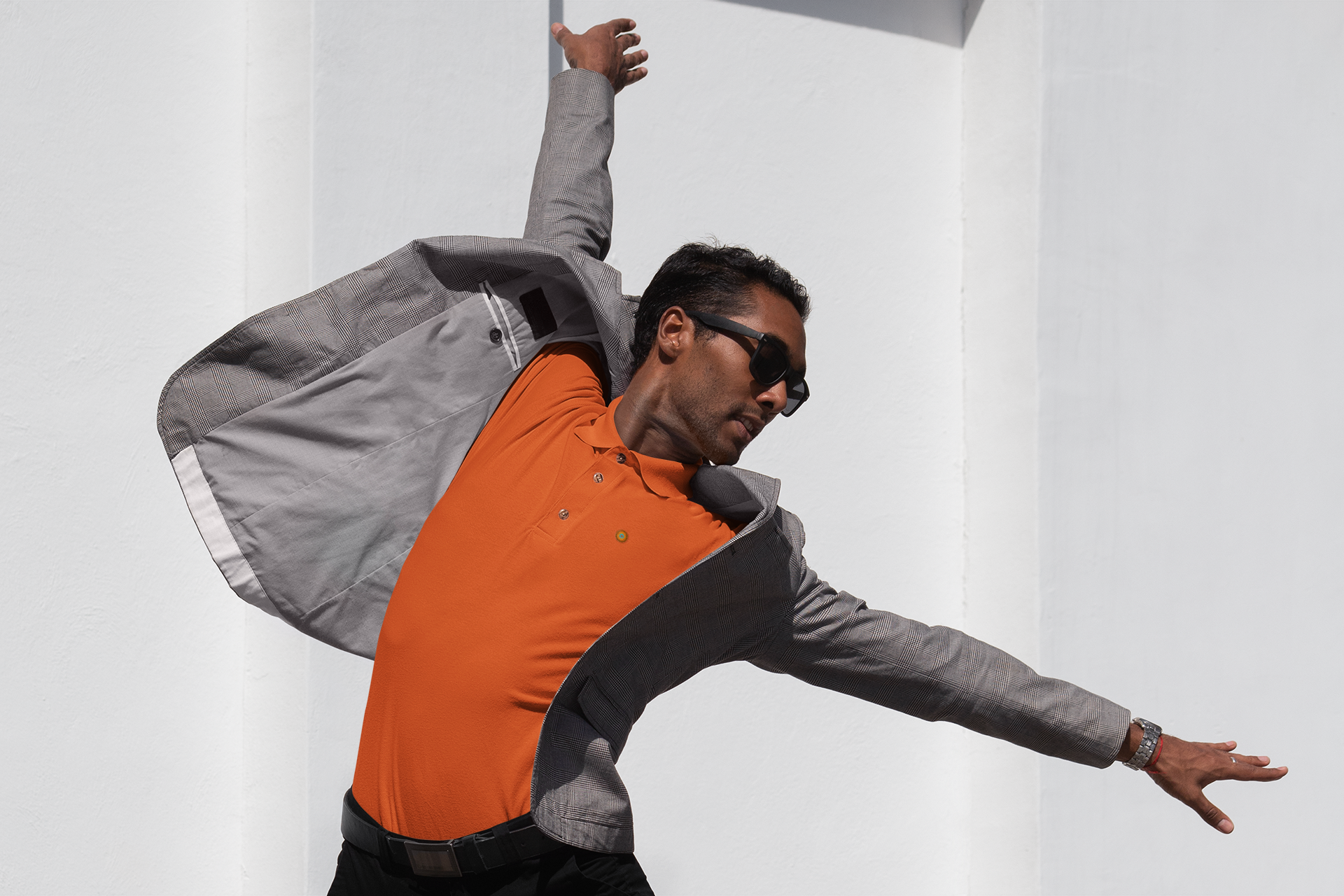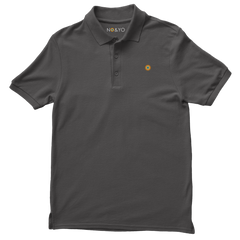Athlete models - is that an oxymoron?
NO&YO started with the idea that everyone who was willing to break the barriers of the commonplace stands at the core of our company philosophy. Men, and also women who have tackled huge hurdles and continue to do so, inspire our company to remain true to ideals where general perceptions of anything become nullified and accomplishments become center point. It is only natural for NO&YO to be compelled to share certain stories of athletes who have endeavored to go and conquer their dreams. More importantly we share their stories because we sympathize with their collective struggles despite their athletic accomplishments and we support that which makes them real.
The sports apparel company
Oiselle made headlines last year when it used models as well as athletes on its runway during a fashion show in New York. Even though sports companies have a history of using models that also happen to be avid athletes; they use models first, athletes second.
This year, however, and fortunately, Oiselle decided to use only athletes during their second year of the Fashion Week in New York, they went for using athlete models only. They used 10 elite female runners who probably feel more at home on a running track than on a runway.
Amongst the ten was an Olympian Kara Goucher (36) and
Lauren Fleshmen (33), NCAA five-kilometer champion from Stanford. Both are successful women and moms and both are redefining what it means to be a female athlete.
Lauren is especially very candid in discussing various gender and body issues on her blog and even posted photos of
cellulite on her leg as well as her post-birth stomach to start a conversation about what women are suppose to look like.
On a blog she also recently posted an article that dealt with a comment she received based on a photo of her taken at the Fashion Show.

************************************************************************************
Please enjoy Lauren's post:
Do I Look Like a Man?
Female athletes come in all shapes and sizes and our definition of femininity has to catch up.
I used to be afraid to call myself a feminist. It sounded like the kind of woman a man wouldn’t like.
I used to look at runway photos in fashion magazines as a pre-pubescent teenager and pray that puberty would be good to me, giving me height with the right kind of curves.
I used to look at photos of some of the fastest pro women runners in the world and think “she looks like a man,” wondering how years of training would change my body and if I’d give up performance at some point to maintain more “femininity.”
Feminist. Fashion. Feminity. Those three areas of my identity have swirled around me in separate storms all my life, until the past two years in which their winds have aligned into one tornado. A tornado that touched down on the fashion runway, wearing a crop top racing singlet and leggings.
Cue the lights.
Cue the music.
The distinct voice of Nigerian Feminist Chimamanda Ngozi Adichie, sampled over a techno beat, reverberates through the audience. Nobody walks out. As the first model in Oiselle’s lineup, I am focused, awaiting my cue at the threshold of the runway. I am not to emerge from behind the wall until her final word is spoken and the slow, powerful beat takes over.
“We should all be feminists”
We teach girls to shrink themselves
To make themselves smaller.
We say to girls,
“You can have ambition
But not too much.
You should aim to be successful
But not too successful,
Otherwise you will threaten the man.”
Because I am female
I am expected to aspire to marriage.
I am expected to make my life choices
Always keeping in mind that
Marriage is the most important.
Now marriage can be a source of
Joy and love and mutual support
But why do we teach to aspire to marriage
And we don’t teach boys the same?
We raise girls to each other as competitors
Not for jobs or for accomplishments
Which I think can be a good thing
But for the attention of men.
We teach girls that they cannot be sexual beings
In the way that boys are.
Feminist: the person who believes in the social
Political, and economic equality of the sexes.
Goosebumps fan across my quads, and rise up the back of my neck until every follicle of my carefully styled coif stands at attention. The beat drops. Sally Bergesen, Oiselle’s CEO and lead designer, moves out of my way and nods, and I step with callused bare feet into the floodlights. Unlike last year I don’t feel like an imposter. I feel confident and proud, with nine more athletes behind me ready to take their turn.
Forty-two years ago, Title IX legally ensured women the right to equal play. More women than men run now. Yet, 42 years later, a sports brand putting muscled runners and a hammer thrower on the runway at NY Fashion Week is newsworthy in the New York Times. Why are these two worlds still separate? And how is it stunting our definition of femininity?
Late at night, after the fashion show excitement and post-party was over, I lay in bed scrolling through media articles about our show, and something stopped me cold. Runner’s World posted our runway photos on Facebook and among ALL the positive comments was one man commenting directly on me. He said, “She looks like a man.”
I clicked on the comment box at the bottom and watched the cursor blink. There was so much I wanted to say. But first, did I look like a man? When did that happen? I looked at my picture through his eyes. Kara Goucher destroyed me on a 10 miler a few hours before the show, so I was a bit dehydrated. Somewhat androgynous maybe with a lean frame, muscle definition, and a sharpish jaw. But the fact is, I am a woman, and a super competitive professional athlete of 12 years, and this is what I look like. Five minutes ago I felt beautiful. I typed and erased several times before deciding to turn off my phone.
His remark stuck with me for several days, like a bruise, and eventually I realized it wasn’t about me. I began to think bigger, and think about change. At what point does physical strength become a trait reserved for men? When exactly do you cross the line? Is it the same point where courage becomes having balls? The same point where getting it done becomes manning up? Why is there no female corollary for these terms? And why do I, as a feminist, continue to use the dude ones?
Our definition of femininity still has some expanding to do to catch up with the fact that women are athletes now, in lots of shapes and sizes. Women do sports. In droves. Fashion plays a huge role in defining femininity, so to the runway we must go.
It’s time to Woman Up.
The fashion barrier is begging to be broken.
************************************************************************************

So what do you think of this athlete model? In the discussions of why do women care of what other people think of their bodies or whether they look like a man, even if they absolutely don’t, topics like Lauren’s in her post are necessary. They’re necessary for a discussion to open, they’re needed for all the little girls that need to grow into strong women and they’re needed if we want the world to catch up with women. And NO&YO is 100% part of that movement!
If you liked what you read, don’t forget to sign up for our email updates, get 15% off your first on-line purchase and be entered into monthly drawing of
NO&YO gear!
Get social with us on
Instagram or
Facebook!
 ************************************************************************************
Please enjoy Lauren's post:
Do I Look Like a Man?
Female athletes come in all shapes and sizes and our definition of femininity has to catch up.
I used to be afraid to call myself a feminist. It sounded like the kind of woman a man wouldn’t like.
I used to look at runway photos in fashion magazines as a pre-pubescent teenager and pray that puberty would be good to me, giving me height with the right kind of curves.
I used to look at photos of some of the fastest pro women runners in the world and think “she looks like a man,” wondering how years of training would change my body and if I’d give up performance at some point to maintain more “femininity.”
Feminist. Fashion. Feminity. Those three areas of my identity have swirled around me in separate storms all my life, until the past two years in which their winds have aligned into one tornado. A tornado that touched down on the fashion runway, wearing a crop top racing singlet and leggings.
Cue the lights.
Cue the music.
The distinct voice of Nigerian Feminist Chimamanda Ngozi Adichie, sampled over a techno beat, reverberates through the audience. Nobody walks out. As the first model in Oiselle’s lineup, I am focused, awaiting my cue at the threshold of the runway. I am not to emerge from behind the wall until her final word is spoken and the slow, powerful beat takes over.
“We should all be feminists”
We teach girls to shrink themselves
To make themselves smaller.
We say to girls,
“You can have ambition
But not too much.
You should aim to be successful
But not too successful,
Otherwise you will threaten the man.”
Because I am female
I am expected to aspire to marriage.
I am expected to make my life choices
Always keeping in mind that
Marriage is the most important.
Now marriage can be a source of
Joy and love and mutual support
But why do we teach to aspire to marriage
And we don’t teach boys the same?
We raise girls to each other as competitors
Not for jobs or for accomplishments
Which I think can be a good thing
But for the attention of men.
We teach girls that they cannot be sexual beings
In the way that boys are.
Feminist: the person who believes in the social
Political, and economic equality of the sexes.
Goosebumps fan across my quads, and rise up the back of my neck until every follicle of my carefully styled coif stands at attention. The beat drops. Sally Bergesen, Oiselle’s CEO and lead designer, moves out of my way and nods, and I step with callused bare feet into the floodlights. Unlike last year I don’t feel like an imposter. I feel confident and proud, with nine more athletes behind me ready to take their turn.
Forty-two years ago, Title IX legally ensured women the right to equal play. More women than men run now. Yet, 42 years later, a sports brand putting muscled runners and a hammer thrower on the runway at NY Fashion Week is newsworthy in the New York Times. Why are these two worlds still separate? And how is it stunting our definition of femininity?
Late at night, after the fashion show excitement and post-party was over, I lay in bed scrolling through media articles about our show, and something stopped me cold. Runner’s World posted our runway photos on Facebook and among ALL the positive comments was one man commenting directly on me. He said, “She looks like a man.”
I clicked on the comment box at the bottom and watched the cursor blink. There was so much I wanted to say. But first, did I look like a man? When did that happen? I looked at my picture through his eyes. Kara Goucher destroyed me on a 10 miler a few hours before the show, so I was a bit dehydrated. Somewhat androgynous maybe with a lean frame, muscle definition, and a sharpish jaw. But the fact is, I am a woman, and a super competitive professional athlete of 12 years, and this is what I look like. Five minutes ago I felt beautiful. I typed and erased several times before deciding to turn off my phone.
His remark stuck with me for several days, like a bruise, and eventually I realized it wasn’t about me. I began to think bigger, and think about change. At what point does physical strength become a trait reserved for men? When exactly do you cross the line? Is it the same point where courage becomes having balls? The same point where getting it done becomes manning up? Why is there no female corollary for these terms? And why do I, as a feminist, continue to use the dude ones?
Our definition of femininity still has some expanding to do to catch up with the fact that women are athletes now, in lots of shapes and sizes. Women do sports. In droves. Fashion plays a huge role in defining femininity, so to the runway we must go.
It’s time to Woman Up.
The fashion barrier is begging to be broken.
************************************************************************************
************************************************************************************
Please enjoy Lauren's post:
Do I Look Like a Man?
Female athletes come in all shapes and sizes and our definition of femininity has to catch up.
I used to be afraid to call myself a feminist. It sounded like the kind of woman a man wouldn’t like.
I used to look at runway photos in fashion magazines as a pre-pubescent teenager and pray that puberty would be good to me, giving me height with the right kind of curves.
I used to look at photos of some of the fastest pro women runners in the world and think “she looks like a man,” wondering how years of training would change my body and if I’d give up performance at some point to maintain more “femininity.”
Feminist. Fashion. Feminity. Those three areas of my identity have swirled around me in separate storms all my life, until the past two years in which their winds have aligned into one tornado. A tornado that touched down on the fashion runway, wearing a crop top racing singlet and leggings.
Cue the lights.
Cue the music.
The distinct voice of Nigerian Feminist Chimamanda Ngozi Adichie, sampled over a techno beat, reverberates through the audience. Nobody walks out. As the first model in Oiselle’s lineup, I am focused, awaiting my cue at the threshold of the runway. I am not to emerge from behind the wall until her final word is spoken and the slow, powerful beat takes over.
“We should all be feminists”
We teach girls to shrink themselves
To make themselves smaller.
We say to girls,
“You can have ambition
But not too much.
You should aim to be successful
But not too successful,
Otherwise you will threaten the man.”
Because I am female
I am expected to aspire to marriage.
I am expected to make my life choices
Always keeping in mind that
Marriage is the most important.
Now marriage can be a source of
Joy and love and mutual support
But why do we teach to aspire to marriage
And we don’t teach boys the same?
We raise girls to each other as competitors
Not for jobs or for accomplishments
Which I think can be a good thing
But for the attention of men.
We teach girls that they cannot be sexual beings
In the way that boys are.
Feminist: the person who believes in the social
Political, and economic equality of the sexes.
Goosebumps fan across my quads, and rise up the back of my neck until every follicle of my carefully styled coif stands at attention. The beat drops. Sally Bergesen, Oiselle’s CEO and lead designer, moves out of my way and nods, and I step with callused bare feet into the floodlights. Unlike last year I don’t feel like an imposter. I feel confident and proud, with nine more athletes behind me ready to take their turn.
Forty-two years ago, Title IX legally ensured women the right to equal play. More women than men run now. Yet, 42 years later, a sports brand putting muscled runners and a hammer thrower on the runway at NY Fashion Week is newsworthy in the New York Times. Why are these two worlds still separate? And how is it stunting our definition of femininity?
Late at night, after the fashion show excitement and post-party was over, I lay in bed scrolling through media articles about our show, and something stopped me cold. Runner’s World posted our runway photos on Facebook and among ALL the positive comments was one man commenting directly on me. He said, “She looks like a man.”
I clicked on the comment box at the bottom and watched the cursor blink. There was so much I wanted to say. But first, did I look like a man? When did that happen? I looked at my picture through his eyes. Kara Goucher destroyed me on a 10 miler a few hours before the show, so I was a bit dehydrated. Somewhat androgynous maybe with a lean frame, muscle definition, and a sharpish jaw. But the fact is, I am a woman, and a super competitive professional athlete of 12 years, and this is what I look like. Five minutes ago I felt beautiful. I typed and erased several times before deciding to turn off my phone.
His remark stuck with me for several days, like a bruise, and eventually I realized it wasn’t about me. I began to think bigger, and think about change. At what point does physical strength become a trait reserved for men? When exactly do you cross the line? Is it the same point where courage becomes having balls? The same point where getting it done becomes manning up? Why is there no female corollary for these terms? And why do I, as a feminist, continue to use the dude ones?
Our definition of femininity still has some expanding to do to catch up with the fact that women are athletes now, in lots of shapes and sizes. Women do sports. In droves. Fashion plays a huge role in defining femininity, so to the runway we must go.
It’s time to Woman Up.
The fashion barrier is begging to be broken.
************************************************************************************
 So what do you think of this athlete model? In the discussions of why do women care of what other people think of their bodies or whether they look like a man, even if they absolutely don’t, topics like Lauren’s in her post are necessary. They’re necessary for a discussion to open, they’re needed for all the little girls that need to grow into strong women and they’re needed if we want the world to catch up with women. And NO&YO is 100% part of that movement!
If you liked what you read, don’t forget to sign up for our email updates, get 15% off your first on-line purchase and be entered into monthly drawing of NO&YO gear!
Get social with us on Instagram or Facebook!
So what do you think of this athlete model? In the discussions of why do women care of what other people think of their bodies or whether they look like a man, even if they absolutely don’t, topics like Lauren’s in her post are necessary. They’re necessary for a discussion to open, they’re needed for all the little girls that need to grow into strong women and they’re needed if we want the world to catch up with women. And NO&YO is 100% part of that movement!
If you liked what you read, don’t forget to sign up for our email updates, get 15% off your first on-line purchase and be entered into monthly drawing of NO&YO gear!
Get social with us on Instagram or Facebook!








